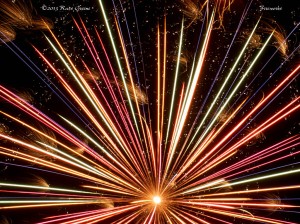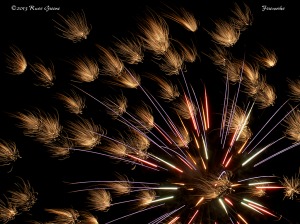
I wish I had posted this a week or so ago in order to give you a little more of an opportunity to soak it all in, but better a little late than never. Right? There’s still a day till the 4th.
Fireworks are intensely hot explosions but photos of fireworks can be pretty cool. How’s that for some clever word play? OK, forget that… I’ve had a glass of wine…

Seriously, getting good photos of fireworks requires both knowing how as well as good luck. I can help with the first part.
In terms of equipment, a tripod is essential. After that, it’s best to have a camera with the ability to set it manually and ideally a “bulb” option for shutter speed. A mechanical cable release or electronic shutter release is necessary for best results because it’s difficult if not impossible to open and close the shutter without shaking the camera without one. Using the bulb setting allows you to control both when the exposure begins and ends. Press the release to open the shutter and let go of it to close the shutter. The idea is to open the shutter and begin the exposure while the sky is dark, between bursts of fireworks, then to close the shutter when you think you’ve captured what you want. This could be a moment after the burst of a rocket or you could allow several rockets to explode. You have to try to imagine what the photo will look like with each successive burst overlaying the previous burst(s) capture. Today’s digital cameras with instant playback are absolutely fabulous because you have instant feedback of the image capture at your fingertips. You can go to a fireworks display as a complete fireworks photographer amateur and via the feedback from instant playback learn enough to leave the show a fireworks photographer expert… well, almost.

A zoom lens can be very helpful for shooting fireworks because it can be difficult to know how close the fireworks will be and how much of the field of view they will occupy in your camera’s viewfinder. If you don’t have a zoom then use what you have. If you’ve attended the same show in previous years this might give you an edge in terms of where you position yourself. A lot of this is guesswork and some of it is luck. This is why a zoom lens can be very useful. If the fireworks are too far away for you to fill much or all of the frame they can look too small to be really interesting. Cropping in on them later with a photo editing program can sometimes help out here.

In terms of ISO, try 100 at an aperture of f/8, or ISO 200 at f/11 for starters. The exposure for each of these will be the same but with f/11 the depth of field will be greater. If the results are too dark then try raising the ISO. If they are too bright lower the ISO or raise the f number.

It’s really difficult if not impossible to focus on fireworks as they are happening, so what you’ll want to do is focus your lens manually at infinity. Make sure to turn off auto-focus. Zoom in on results early in the show to see if they are in focus. If not, you can try refocusing a little closer or further away then rechecking. Alternatively, stopping down to a higher f number will increase the depth of field. Depth of field is the point at which acceptable focus begins to where it ends. The higher the f number the greater the depth of field, but also the less light that will reach your camera’s sensor or film. An exposure of f/11 at ISO 200 is equivalent to f/8 at ISO 100 but you will have greater depth of field at f/11. Whenever you increase the f number you will need to increase the ISO if you want to maintain the same exposure. Increasing the ISO also increases the noise in photos. Noise in digital photos is akin to graininess in film photos. Generally, you want to minimize it. So, for shooting fireworks just as anything else, unless you want noise for effect, you’ll want to shoot at the lowest ISO possible.

Take a flashlight to the fireworks with you. You will need to it make adjustments to the camera settings. I like headlamps because they leave both hands free.
I think that’s pretty much it. If you’re not really familiar with setting your camera manually then practice a little before the fireworks because it will be difficult to figure out in the dark and you’ll miss some of the shooting opportunity. So, Happy Independence Day and good shooting.
This blog takes an enormous amount of time and energy to build and maintain . If you have found something useful or entertaining please Favorite (bookmark) this Amazon.com link and use it when you shop at Amazon. Doing so will cost you no more and in some cases I may receive a small commission. Your support in the form of using my Amazon.com link or making a PayPal Donation will be greatly appreciated. Thank you.
